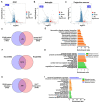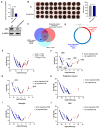Krüppel-like Transcription Factor 7 Is a Causal Gene in Autism Development
- PMID: 35328799
- PMCID: PMC8949233
- DOI: 10.3390/ijms23063376
Krüppel-like Transcription Factor 7 Is a Causal Gene in Autism Development
Abstract
Background: Autism spectrum disorder (ASD) is a complex neurodevelopmental disease. To date, more than 1000 genes have been shown to be associated with ASD, and only a few of these genes account for more than 1% of autism cases. Klf7 is an important transcription factor of cell proliferation and differentiation in the nervous system, but whether klf7 is involved in autism is unclear.
Methods: We first performed ChIP-seq analysis of klf7 in N2A cells, then performed behavioral tests and RNA-seq in klf7+/- mice, and finally restored mice with adeno-associated virus (AAV)-mediated overexpression of klf7 in klf7+/- mice.
Results: Klf7 targeted genes are enriched with ASD genes, and 631 ASD risk genes are also differentially expressed in klf7+/- mice which exhibited the core symptoms of ASD. When klf7 levels were increased in the central nervous system (CNS) in klf7+/- adult mice, deficits in social interaction, repetitive behavior and majority of dysregulated ASD genes were rescued in the adults, suggesting transcriptional regulation. Moreover, knockdown of klf7 in human brain organoids caused dysregulation of 517 ASD risk genes, 344 of which were shared with klf7+/- mice, including some high-confidence ASD genes.
Conclusions: Our findings highlight a klf7 regulation of ASD genes and provide new insights into the pathogenesis of ASD and promising targets for further research on mechanisms and treatments.
Keywords: ASD; human brain organoids; klf7; klf7+/− mice; regulatory gene.
Conflict of interest statement
The authors declare that they have no competing interests.
Figures





Similar articles
-
Krüppel-like factor 7 deficiency causes autistic-like behavior in mice via regulating Clock gene.Cell Biosci. 2022 Oct 7;12(1):166. doi: 10.1186/s13578-022-00903-6. Cell Biosci. 2022. PMID: 36207723 Free PMC article.
-
Krüppel-like factor 7 deficiency disrupts corpus callosum development and neuronal migration in the developing mouse cerebral cortex.Brain Pathol. 2023 Sep;33(5):e13186. doi: 10.1111/bpa.13186. Epub 2023 Jul 3. Brain Pathol. 2023. PMID: 37401095 Free PMC article.
-
Transcription factor KLF7 regulates differentiation of neuroectodermal and mesodermal cell lineages.Exp Cell Res. 2010 Aug 15;316(14):2365-76. doi: 10.1016/j.yexcr.2010.05.021. Epub 2010 May 24. Exp Cell Res. 2010. PMID: 20580711
-
Molecular function of Krüppel-like factor 7 in biology.Acta Biochim Biophys Sin (Shanghai). 2023 May 24;55(5):713-725. doi: 10.3724/abbs.2023061. Acta Biochim Biophys Sin (Shanghai). 2023. PMID: 37227154 Free PMC article. Review.
-
[Research progress of Krüppel-like factor 7].Sheng Li Xue Bao. 2016 Dec 25;68(6):809-815. Sheng Li Xue Bao. 2016. PMID: 28004076 Review. Chinese.
Cited by
-
Krüppel-like factor 7 deficiency causes autistic-like behavior in mice via regulating Clock gene.Cell Biosci. 2022 Oct 7;12(1):166. doi: 10.1186/s13578-022-00903-6. Cell Biosci. 2022. PMID: 36207723 Free PMC article.
-
Multiplexed CRISPRi Reveals a Transcriptional Switch Between KLF Activators and Repressors in the Maturing Neocortex.bioRxiv [Preprint]. 2025 Feb 15:2025.02.07.636951. doi: 10.1101/2025.02.07.636951. bioRxiv. 2025. PMID: 39975013 Free PMC article. Preprint.
-
Ocular and neural genes jointly regulate the visuospatial working memory in ADHD children.Behav Brain Funct. 2023 Sep 1;19(1):14. doi: 10.1186/s12993-023-00216-9. Behav Brain Funct. 2023. PMID: 37658396 Free PMC article.
References
-
- Hyman S.L., Levy S.E., Myers S.M., Council On Children With Disabilities. Section on Developmental and Behavioral Pediatrics. Kuo D.Z., Apkon S., Davidson L.F., Ellerbeck K.A., Foster J.E.A., et al. Identification, Evaluation, and Management of Children With Autism Spectrum Disorder. Pediatrics. 2020;145:e20193447. doi: 10.1542/peds.2019-3447. - DOI - PubMed
-
- Chiocchetti A.G., Kopp M., Waltes R., Haslinger D., Duketis E., Jarczok T.A., Poustka F., Voran A., Graab U., Meyer J., et al. Variants of the CNTNAP2 5’ promoter as risk factors for autism spectrum disorders: A genetic and functional approach. Mol. Psychiatry. 2015;20:839–849. doi: 10.1038/mp.2014.103. - DOI - PubMed
MeSH terms
Substances
LinkOut - more resources
Full Text Sources
Medical
Molecular Biology Databases

